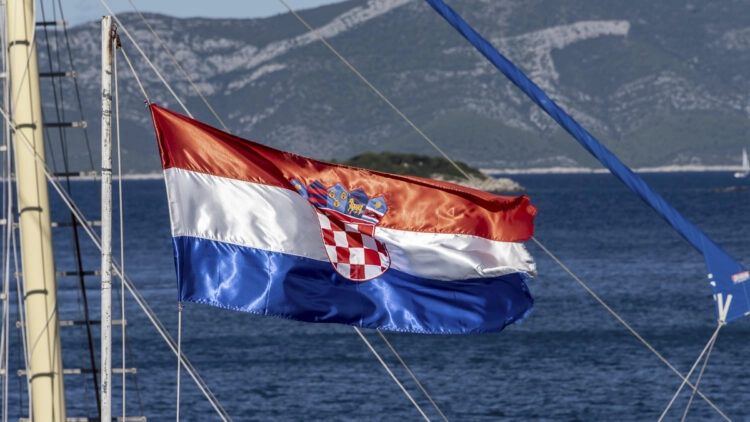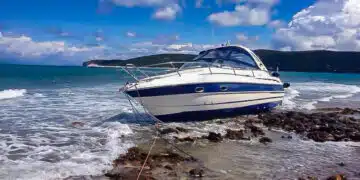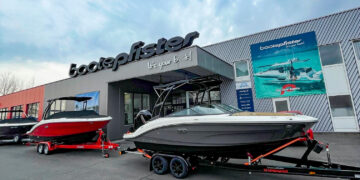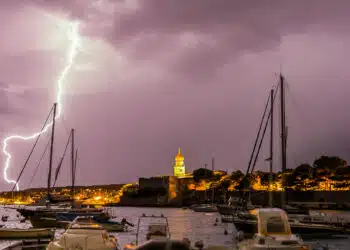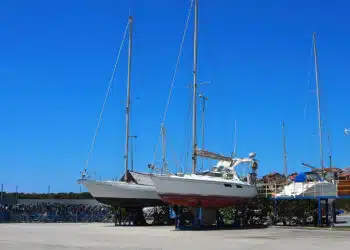What is a flag and how does it differ from a flag? Well, it’s quite simple: a flag is initially quite simply a rectangular, single- or multi-colored (also: patterned in different colors) piece of cloth, which is inlaid on one narrow side (the hot) and is provided with an eye of cordage at the upper end of the leech, with a swivel or toggle at the lower end, and if necessary also with a flag line shackle – flag guidance skipper tips from the SeaHelp editorial team for a successful trip.
For each letter there is a separate letter flag, which belongs to the so-called flag alphabet. In addition, sailors distinguish national flags, racing flags, protest flags and house flags. So far, so good. By the way, in contrast to a flag, the flag is always flown on an extra flag line and is also set and lowered with it. The yacht owner proves the right to fly the federal flag by a flag certificate, the correct handling of a flag in general is called flag handling. Every skipper should be familiar with it.
Every skipper should be familiar with flag handling on the cruise
Basically, every vessel is required thereafter to display the flag of the state in which it is registered on the flagstaff during the day. It is hoisted (set) at sunrise and lowered at dusk. The exceptions are the standards of heads of state, admiral’s flags and commander’s pennants, which are “illuminated by the moon and the sun”.
The hoisting and lowering of the flag on warships is honored with a ceremonial flag parade. It is accompanied by music if a music corps is available, otherwise the boatswain’s whistle is used. Incidentally, the “flag at half mast” is a remnant of the time when people on board mourned “in sackcloth and ashes”, for example when the captain had died. Then the yards and rigging were deliberately put in disorder.
Not only tradition: flag gala, flag salute & Co.
The flag gala (flag dressing, dressed full), sometimes also called flag decoration, is set on festive occasions. In this case, the signal flags are placed in a row lengthwise ship over the tops (mastheads). Sailors therefore also say “flag over the tops”.
As a rule, flags are not set at sea and in bad weather, so as not to simulate the international distress signal when two flags are flying under one spreader. Instead, flags are only set near shore and when meeting other vessels for dipping in what is called the flag salute.
In the flag salute (flag dipping, flag salute), meeting vehicles greet each other by the so-called dipping of the national. And it works like this: the first saluting yacht brings down its flag halfway and does not call it forward again until the other one has set its flag again after dipping. By the way: the moving boat always salutes the stationary boat, an outgoing boat salutes the boat in port, an outgoing boat salutes the incoming boat and an overtaking boat salutes the overtaken boat! Important: warships are always greeted first.
Where is the national set – and what is the flag parade all about?
The national flag (national ensign) is flown on the flagstaff at the stern of dinghies and smaller yachts, on the upper third of the mainsail leech of larger yachts, on the gaff of the mainsail in the case of gaff rigging, and on the top of the mizzenmast in the case of a ketch or yawl.
Flags of the host country are placed under the starboard spreaders of the mainmast in the case of sailing ships, and at a comparable place in the case of motor ships, but in any case always higher than your own. When entering the first own port, a gala consisting of all flags of the countries visited on the way can be set.
During the flag parade (coulours) all boats in the harbor set the national or other flags together, or they collect them together. From May 1 to September 30, the flags are hoisted at 8 a.m., and at 9 a.m. in the other months. It is best to follow the flagpole of the local sailing club, warships or the largest yacht. The common hauling down takes place at sunset. By the way, if the crew is not on board at that time, they collect their flags beforehand.
A farewell flag – and for emergencies on board
The farewell signal on a ship leaving port within 24 hours is the signal flag P, called Blue Peter (Blauer Peter), which also used to be used to tell the crew to get on board immediately.
A simple signal of distress on board, by the way, is the so-called “flag in show” (flag with a wheft/waft). For this purpose, a simple overhand knot is tied in the cloth of the Nationale, which is run in its usual place (see above).


